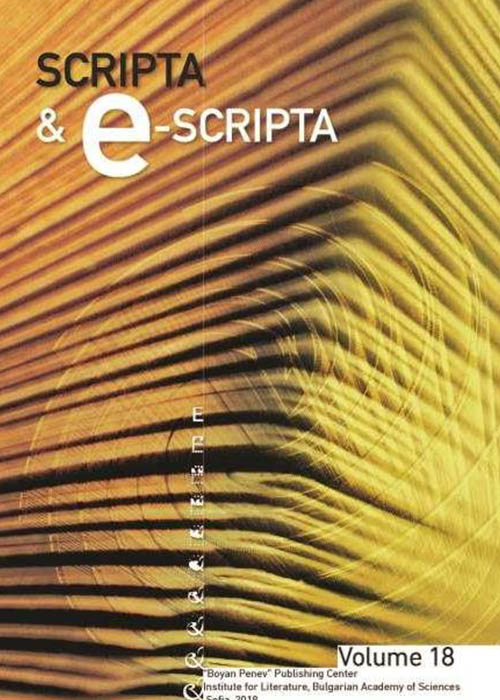Content structuring in St Petersburg Corpus of Hagiographic Texts (SCAT)
Структуриране на съдържанието на Санкт-Петербургския корпус от агиографски текстове (СКАТ)

- Author(s): Irina Azarova Elena Alekseeva Alexei Lavrentiev Elena Rogozina Konstantin Sipunin
- Subject(s): Digital humanities //
-
Published by: Institute for Literature BAS

- Print ISSN: 1312-238X
- Summary/Abstract:
The St Petersburg Corpus of Hagiographic Texts (SCAT) has launched two new mark-up formats. The first innovation is the comprehensive format developed for the division of hagiographic texts into parts, which are both explicitly marked as section headings and extrapolated through comparison with texts of the similar genre. The second innovation is an elaborate format representing the full range of various types of biblical, patristic and liturgical quotations occurring in the lives of saints. For the time being, three morphologically annotated manuscript texts have been marked up according to these guidelines, and we are planning to add two more texts in the near future. Close cooperation with the IHRIM research laboratory (Lyon) and wide use of their techniques and technology makes it possible to obtain some illuminating cross- format statistical data and thus offer new insights into the canons and rules of the Old Russian hagiography.
Journal: Scripta & e-Scripta vol. 21, 2021
-
Page Range: 69-78
No. of Pages: 10
Language: English - LINK CEEOL:
-
Irina AzarovaRussiaSaint Petersburg State UniversityDescription
Irina Azarova is an Associate Professor in Mathematical Linguistics at Saint Petersburg State University, Russia. Research Interests: computer lexicography, corpus analysis, and lexical corpus statistics.
Elena AlekseevaRussiaSaint Petersburg State UniversityDescriptionElena Alekseeva is an Associate Professor in Mathematical Linguistics at Saint Petersburg State University, Russia. Her principal research interest lies in the application of computer technology to the study of medieval Slavic manuscripts.
Alexei LavrentievFranceIHRIM Laboratory, CNRS, Lyon, FranceDescriptionAlexei Lavrentiev, PhD (Linguistics), is a research Engineer at IHRIM Laboratory, CNRS, Lyon, France. His fields of interest include corpus linguistics, digital philology, textometry and history of the French language. He is the manager of the Base de français médiéval corpus (http://bfm-corpus.org), co-editor of the digital edition of La Queste del saint Graal and member of the TXM development team. He teaches at École normale supérieure de Lyon and at Novosibirsk State University. A. Lavrentiev has been involved in a number of French and international funded research projects including Oriflamms (Ontology Research, Image Features, Letterform Analysis on Multilingual Medieval Scripts), Interaction of languages and cultures in the universe of francophone Russian personal diaries in the 19th century. Personal webpage: http:// ihrim.ens-lyon.fr/auteur/lavrentev-alexei.
Elena RogozinaRussiaSaint Petersburg State UniversityDescriptionElena Rogozina is a Senior Lecturer at the Department of Mathematical and Applied Linguistics of Saint Petersburg State University (Russia). She is a part of the team working on the SCAT (St Petersburg Corpus of Hagiographic texts) and has published a number of articles on characteristics and mark-up of the content structure of the Corpus texts.
Konstantin SipuninRussiaSaint Petersburg State UniversityDescriptionKonstantin Sipunin is a postgraduate student of Linguistics at Saint Petersburg State University, where he formerly obtained a BA and an MA in Applied and Computational Linguistics. His graduation theses dealt with issues of lemmatization as applied to Church Slavonic lives of saints. His research interests include formal morphology and digital representation of historical texts.
-
SUBJECT: Digital humanities //KEYWORDS: diachronic text corpus // Old Russian hagiography // TXM technology // content structuring // Biblical quotations //
-